Education tomorrow


About: “Education will become the largest single industry and entertainment a close second-or mankind would die of utter boredom in a workless world.” Arthur C. Clarke.
This may turn out to be true. However, reality or not, education will be radically different than it is today. More reactive, flexible and customized for people. We start with two extremes: letting learning happen versus “beware of firsthand ideas”. The School in the Cloud from decades ago, to burning books in Fahrenheit 451 to how leading organizations are making learning real, with examples from NASA, UPS, Sanofi Pasteur and Wikipedia. In addition, we talk about initiatives like stackable credentials and open knowledge in Africa that offer new opportunities and inspiration. The examples here show how education is being shaped beyond time and place.
_________________________________________________________________
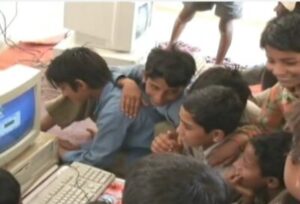 The formalization of SOLE: self-organized learning environments, is a concept created by Sugata Mitra.
The formalization of SOLE: self-organized learning environments, is a concept created by Sugata Mitra.
I wrote about the “Hole in the Wall” experiment in 2005, sixteen years ago. The sub title of the original article was “Let people get on with it”. It described an early initiative in the ongoing work of educational pioneer Sugata Mitra. In 1999, he broke a hole in the wall between his office and a slum in India and made a computer available to children who had never before seen one.
A quote from the BBC article caught my attention back in 2005. Mitra, observing the children, said: “You find that the noise level begins to come down, and from somewhere a leader appears. Often his face is not visible in the crowd, but he is controlling the mouse because suddenly you see the mouse begin to move in an orderly fashion.”
“It’s not about making learning happen, it’s about letting learning happen.”
Since then, Mitra has gone far in his work and you can hear about it firsthand in his TED talk in 2010 and again in 2013 where he won the TED Prize of one million dollars:
“Help me design the School in the Cloud, a learning lab in India, where children can explore and learn from each other — using resources and mentoring from the cloud.”
As I said in my blog post back then, “This (story) illustrates how leaders emerge naturally and groups are capable of self-regulation and self-teaching given the opportunity, time and motivation.”
Mitra said: “”It’s not about making learning happen, it’s about letting learning happen.”
Going even further back in time, E.M. Forster wrote The Machine Stops in 1909.
Humanity has lost its way. It depleted the world of natural riches and people are living in hermetically sealed rooms in the machine and communicate via monitors.
Sound familiar today?
We follow the life of Vashti, a woman in the machine and and Kuno, her daring, sacrilegious son through this new unlivable world.
“People cannot think for themselves. They live in this world where ‘first-hand ideas do not really exist’.”
“They are but the physical impressions produced by love and fear, and on this gross foundation who could erect a philosophy? Let your ideas be second-hand, and if possible tenth-hand, for then they will be far removed from that disturbing element — direct observation. Do not learn anything about this subject of mine — the French Revolution. Learn instead what I think that Enicharmon thought Urizen thought Gutch thought Ho-Yung thought Chi-Bo-Sing thought Lafcadio Hearn thought Carlyle thought Mirabeau said about the French Revolution.”
This is a story you will never forget. You ca download a free pdf here. (Click and get the pdf immediately.)
This all rings so true in our world today, over 110 years after The Machine Stops was written. People of all ages, but especially the young, live much of their lives in virtual worlds on their phones and computers.
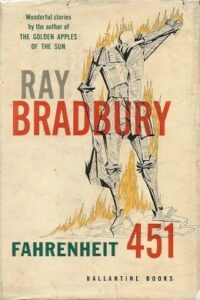 Carrying books in our heads
Carrying books in our headsFahrenheit 451 takes place in American society at a time where books have been personified and outlawed. The fire departmenents seek them out and burn them. Written in 1953, you cannot help but think about the current movements in the United States (and some other places) where books are banned.
In Fahrenheit 451, Ray Bradbury describes the long march of believers, memorizers who carried books in their heads, and who believed that books are the life vessel for the future. Burning the paper did not matter.
Can we say the same for the current wave in the United States today of banning certain books from classrooms and libraries? Does banning a book remove it or call attention to it? We will see when his destructive phase ends, if –hopefully – it does.
(Cover illustration Joe Mugnaini.)
It’s hard to believe but true. Students are resisting by organizing to express their desire to read books that some people want to ban.
Schools are limited in Texas, USA, (among other places) restricting what books they have the right to buy because parents and school boards have oversight and the right to ban books they don’t approve of.
I remember my geology teacher from my university days in Arizona many decades ago. He based all his courses on asking us questions. Non-stop for two straight hours, twice a week. We suggested answers and he always followed up with another question. If no one responded, he then rephrased the original question from a different angle. He did no top-down talking.
Could my geology teacher hold down a job today in an American university?
Although I have now been living in Europe for well over half my life, I follow what’s happening in the US extensively as I have family there. Seeing the news on television about the influence of politics and parental preferences on teachers, I think probably not.
There are initiatives that attempt to make learning real, not limited to schools and classrooms. I have some examples, the first from over 50 years ago.
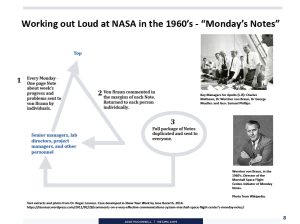 Wernher von Braun, head of the Marshall Space Flight Center (part of NASA) set up a system for working out loud over 50 years ago.“Working Out Loud From the Top – Half a Century Ago – At NASA”.
Wernher von Braun, head of the Marshall Space Flight Center (part of NASA) set up a system for working out loud over 50 years ago.“Working Out Loud From the Top – Half a Century Ago – At NASA”.
He asked each of his senior managers to send him a one-page note each Monday listing the past week’s activities – successes, concerns, questions. He personally noted his comments in the margins of each page, and returned each one to the original writer. The ultimate step – the genius of the approach – was that all the papers were photocopied and shared with all the managers. The system rolled down and included project leaders, R&D people, and so on.
Read more about the approach and the history of working out loud. The term “working out loud” was coined by Bryce Williams the same year. He merged the notions of “narrating your work” and “observable work”:
Without observation, narrating serves no purpose. Without narrating, there is nothing to observe.
Sharing your work with others is part of letting learning happen in the natural flow of work. Quoting from my 10th annual report “The Organization in the Digital Age” I said:
“Learning in the natural flow of work is becoming easier. E-learning, real-time access to experts and communities of practice facilitate learning while working. 56% now say it is easy, compared to 23% three years ago. Responsibility for learning lies primarily with people themselves, rather than their manager or the HR department.”
56% is not high. That means just over half! It’s good that learning in the natural flow of work has increased. is coming down to the individual but the system must let it happen!
 I interviewed Mark Gröb, of Immersive Tech Center for UPS, talked to me a few years ago about how UPS was using what he called “extended reality” to train new workers and help them understand what he called the “cornerstones” of their work. They go through a critical chain of learning in order to understand how to do their jobs successfully. This is a new way of learning in the natural flow of work, but the learning actually happens before the real work begins.
I interviewed Mark Gröb, of Immersive Tech Center for UPS, talked to me a few years ago about how UPS was using what he called “extended reality” to train new workers and help them understand what he called the “cornerstones” of their work. They go through a critical chain of learning in order to understand how to do their jobs successfully. This is a new way of learning in the natural flow of work, but the learning actually happens before the real work begins.
“Our mantra: zero errors first time all the time. Because we want the errors being done in simulation, not in production.”
The platforms gave us the ability to actually initiate, not only accelerate learning. The employees themselves are actually initiating the learning. They’re doing it wrong. It’s okay. Because it’s not affecting production. “It’s virtual, you know, it’s just the click of the button or a reset.”
You can read more about it, and listen to Mark explain the process on the Bold New Breed podcast episode 16: eXtended reality increases engagement and learning on my website.
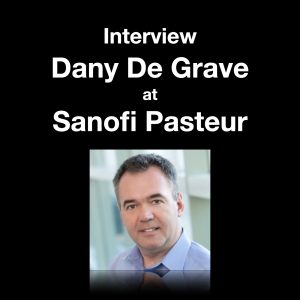 Learn, share, apply
Learn, share, applyIn my “Bold New Breed” podcast, I had a good conversation with Dany De Grave in R&D Digital Transformation at Sanofi Pasteur about an initiative he and colleagues created several years ago.
It is based on Learn, Share, Apply. I suggested to Dany that “Learn” is what most companies do with their institutes and initiatives and so on. I added that “Apply” is one step further and that “Share” is still deeper. That’s what I think is pretty unique about the program Dany and colleagues have designed.
They call it Shift. That suggests to me that there’s something big going on. I asked Dany to talk about this.
“The name Shift refers to the end result. What are we trying to achieve? A shift from an earlier way of working. It’s a more permanent change. You can almost compare it to an earthquake and the plates have shifted and they’re not going to revert back. That’s what we want to see happening. So that’s why it’s called Shift.”
Interestingly, Shift starts with a one-page document. It describes how the business is going to benefit from the training efforts. And then other information like who is doing this, which department, which location, how much time we think we will spend on that. And it describes those three steps.
“It says, I’m going to learn this tool. I’m going to apply it in this way. And then I’m going to share it in this or that way.”
You can listen to Dany talk about it at https://netjmc.com/07-how-can-you-make-learning-come-alive/
Outschool is an inspiring initiative, described in an article in Fast Company: “How Outschool won the pandemic”. (3 November 2022)
“Outschool is trying to reinvent education for children. Even in an era of Zoom fatigue, Outschool managed to hook a million kids on its unique classes, more than quadrupled its value, and recruited 10,000 teachers amid rampant teaching shortages. But can it keep up the momentum?” That’s the real question.
Topics offered cover a wide range of interests: bridge design, molecular gastronomy, Korean language, clarinet lessons and Hindustani classical singing.
Amir Nathoo, CEO and co-founder feels that Out School will continue to thrive even though the pandemic is, in theory, over. It wills needs that traditional education does not.
“There’s still this fundamental underlying challenge, which existed before the pandemic and is worse now, which is, do I believe that my kid is getting what they need in their education to lead a happy and successful life?
“More and more parents feel that they need something else…. That’s driven by the challenges in the existing education system, and also challenges in the world driven by globalization.”
Outschool offers access to subjects and teachers that people cannot have locally. One critical difference between Outschool and traditional schools is that teachers are not required to have formal credentials. In addition, they have creative control over their classes including content and class size.
Nethoo believes the future of education is hybrid, much like some people feel the future of work is hybrid. Time will tell if they are right.
The article is long and full of interesting details. It is definitely worth a read to give you an additional perspective on how education can thrive, in meaningful and useful ways, in our digital era.
 There is a famous unfinished ceiling at the United Nations. It is a timeless reminder for me of how some movements and initiatives will never end. When I took this photo in 2005, I was working with the Secretariat in New York on their digital work environment. When I saw this room, I was stunned by the simplicity, beauty and importance of the message.
There is a famous unfinished ceiling at the United Nations. It is a timeless reminder for me of how some movements and initiatives will never end. When I took this photo in 2005, I was working with the Secretariat in New York on their digital work environment. When I saw this room, I was stunned by the simplicity, beauty and importance of the message.
The Swedish designers decided to finish only part of the ceiling, and to leave a large part uncovered. This lets people in the room see the structural pieces that are not covered by the attractive ceiling finishing materials.
They wanted to make the statement that the work of the Economic and Social Council would never be finished.
The work concerns sustainable development, respect for human rights, eradication of poverty and education issues.
Read about my personal discovery in 2005 on netjmc website.
A relatively new system for developing knowledge and skills without going full time back to school is to acquire stackable credentials. They are also referred to as micro-credentials. This method lets you go step by step, based on your needs and availability, towards your educational goal.
It also lets you orient your learning towards what you current employer needs or what you yourself want to achieve. You may have a career or personal work development goal that you cannot meet in one go because for different reasons you cannot become a full time student. Stackable credentials, a relatively new concept, may be the door for many people.
In “Micro-Credentials: The New Enrollment Funnel for Tomorrow’s University”, you have a good overview of how universities need to adapt their systems and how companies have a role to play. (14 April 2023)
I quote from the introduction:
“Many of us think of higher education as the most effective tool to ensure our long-term career success, but traditional degree programs may not deliver results quickly enough to ensure the immediate job security or advancement employees seek. Universities must meet learners’ needs for continued upskilling and training in ways that qualify them for the jobs they need today and prepare them for the careers they hope to forge tomorrow.
“Micro-credentials offer an excellent bridge to career progression and security for students, and opportunities for higher ed institutions to reach more learners. Through micro-credentials, universities can directly meet the demands of learners and employers—now and in the future.”
The degree model does not fit everyone, especially today. Universities are being by-passed as companies are defining their own qualifications and training approaches.
This bold move (towards micro-credentials) indicates that those in higher ed must rethink their credentialing systems and become nimbler in their approaches.
This is an example of how education is happening outside of the traditional times and places. Personally, I think this trend will develop very fast as people take greater control over their work lives.
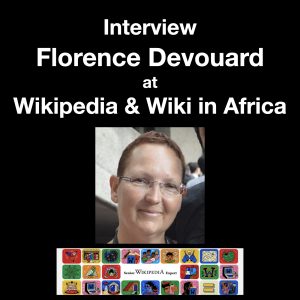 Wiki Africa the last mile
Wiki Africa the last mileI interviewed Florence Devouard for my Bold New Breed podcast. I had met Florence several years ago, and she taught me a lot about the Wikimedia Foundation, of which she served as chair for the Wikimedia Foundation board of trustees from 2006 to 2008.
In the podcast, we talked specifically about her project Wiki in Africa. The points we covered are:
The last mile, or last kilometer, is essential, and this role is played by local partners such as schools, local libraries, community centers or tech spaces in small cities.
Florence:
“I think that what is important when I describe myself is the value I carry and what I want to see change in the world, such as the importance of the value of openness, of collaboration, of free access, to knowledge, to everyone, to knowledge equality. So everything I do is done with these values in mind.”
Will the traditional players in education such as schools and universities continue to manage how people learn, or will there be new models?

In answer to the question above from the Future2043 survey, people were clear: new models are coming. some are already here, as we have seen in this article.
Attitudes from the past as reflected in two scifi examples – Fahrenheit 451 and “The Machine Stops” still exist in our world today. But there is hope when we look at new initiatives such as stackable credentials that are suited to our fast-changing times where jobs for life no longer exist.
UPS and Sanofi Pasteur are two pioneering companies that dared to experiment with new technologies that make learning active and fun. Even though the original spirit of working-out-loud at the Marshall Space Flight Center (NASA) did not last when Wernher von Braun left , the fact that it existed for multiple years was inspirational to many. I have shared the story with many groups of corporate managers who saw it as a realistic, meaningful approach to how people learn in the natural flow of work.
Perhaps the most important invention is the project Wiki in Africa, created by Florence Devouard, to help prepare young Africans for a world of open knowledge. This open world is not yet widespread but, in my opinion, is growing fast every day as people recognize that knowledge shared is knowledge enriched.
Symbols are important and the unfinished ceiling at the Economic and Social Council room at the United Nations is a strong one. I saw it in 2005 and it is still unfinished today, nearly twenty years later.
If Arthur C. Clarke is right, that education will become the largest single industry, the new models described above, and others to be discovered, are a key to our future. They take us to new dimensions, beyond time and space, and open opportunities we cannot yet fully imagine.
Photo credit: Samuel Zeller, Unsplash
Explore references and links related to this article
SOLE: self-organized learning environments, Sugata Mitra. https://www.soleaustralia.com/the-work-of-sugata-mitra.html
School in the cloud
https://netjmc.com/true-leadership-emerges-in-an-inclusive-context/ I wrote about the “Hole in the Wall” experiment in 2005.
https://www.ted.com/talks/sugata_mitra_build_a_school_in_the_cloud accessed 25 July 2023. …more….
The School in the Cloud, by Sugata Mitra. Published by Corwin
Part of the series Corwin Teaching Essentials https://us.corwin.com/books/schools-in-the-cloud-257918, accessed 26 July 2023.
https://web.archive.org/web/20060922135359/http://www.hole-in-the-wall.com/, accessed 26 July 2023
Good history of Sugata Mitra and his work https://en.wikipedia.org/wiki/Sugata_Mitra#cite_note-12
Beware of first-hand ideas.
E.M. Forster wrote The Machine Stopped in 1909. The Machine Stops is available in full text on different websites. You ca download a free pdf here. (Click and get the pdf immediately.)
Fahrenheit 451 by Ray Bradbury. Published in 1953 by Ballantine Books.
The long march of believers, carrying books in their heads
Banning books
Read about banning books in The Washington Post article from 3 May 2022 “Teens fight for the right to read with ‘banned-book clubs’ and lawsuits”. Accessed 28 July 2023 at https://www.washingtonpost.com/education/2022/05/03/teens-books-ban-clubs-protest/
Read about restrictions that limit librarians in The Washington Post article from 22 January 2023 “Students want new books. Thanks to restrictions, librarians can’t buy them.” Accessed 26 July 2023 at https://www.washingtonpost.com/education/2023/01/22/students-want-new-books-thanks-restrictions-librarians-cant-buy-them/
Working out loud
I wrote about an unusual initiative by Wernher von Braun, head of the Marshall Space Flight Center (part of NASA) who set up a system for working out loud over 59 years ago.
“Working Out Loud From the Top – Half a Century Ago – At NASA”. Here it is at
https://netjmc.com/working-out-loud-from-the-top-half-a-century-ago-at-nasa/. Accessed 30 July 2023. Discover the history of working out loud in my article.
Dr. Roger Launius who wrote a description and analysis that is well worth reading. Please take the time to do so. It will give you a new perspective on management. Jane Bozarth, author of Show Your Work, places Launius’s write up in the context of “working out loud”, which is where I discovered this case.
Learning in the flow of work
Key findings from my 10th annual report “The Organization in the Digital Age”, published early 2016 at https://netjmc.com/key-findings-organization-in-the-digital-age-10th-edition/.
UPS and Extended reality
Discover how you can use virtual reality to learn before doing the job. Mark Gröb, head of Immersive Tech Center for UPS on my Bold New Breed podcast explains their approach. Accessed 30 July 2023 at https://netjmc.com/16-extended-reality-increases-engagement-and-learning/
Learn, share, apply
Listen to “How can you make learning come alive?” episode 7 on my Bold New Breed podcast, at https://netjmc.com/07-how-can-you-make-learning-come-alive/. with Dany De Grave of Sanofi Pasteur who describes a non-traditional approach to learning inside an organization. Accessed 30 July 2023.
Outschool
Read about Outschool in How Outschool won the pandemic, published 3 November 2022 in Fast Company, at https://www.fastcompany.com/90729413/how-outschool-won-the-pandemic. Accessed 29 July 2023.
The unfinished ceiling at the UN Economic and Social Council
Read my personal discovery in 2005 of the ceiling here: https://netjmc.com/what-we-can-learn-from-an-unfinished-ceiling/. Accessed 30 July 2023.
See more photos and details on the UN site: https://www.un.org/en/ccoi/ecosoc. Accessed 30 July 2023.
Stackable Credentials
The Wiley website below is inaccessible – “frozen” my browsers says. Update Nov 9
https://universityservices.wiley.com/stackable-credentials/
Krysia Lazarewicz, Vice President of Business Development at Wiley University Services, 14 April 2023, accessed 30 July 2023.
More information
The Strada Center for Education and Consumer Insights, micro-credentials are the education avenue of choice for many Americans looking to upskill. Employers have specific needs, and it’s hard to find trained workers. Some find that the degree model has not produced job-ready talent, so organizations feel they must create their own programs to recruit, train, and place talent within their own ranks.
As businesses seek to improve employee skills and diversity, micro-credentials allow them to bypass universities and confer their own qualifications.
Education for the future: open knowledge, Wiki Africa
https://en.wikipedia.org/wiki/Florence_Devouard
https://netjmc.com/8-florence-devouard-on-a-mission-for-open-knowledge/
Showing 4 of results
Showing 4 of results
Nothing matches your request, please try again with a different search term.
